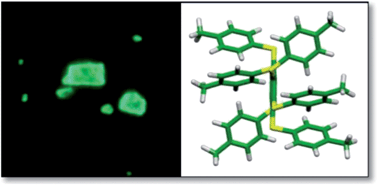A molecule consisting of a hexathio-benzene core and peripheral tolyl substituents exhibits outstanding phosphorescence properties in some environments favoring rigidity, in the solid state and in a solid matrix at 77 K, while no luminescence is recorded in solution at room temperature. This peculiar behavior is attributed to the restriction of bond rotation and conformational mobility of the tolylthio substituents, which slows down the non-radiative deactivation processes of the phosphorescent excited state. The solid material (powder) shows a very high phosphorescence quantum yield (80%), which, to the best of our knowledge, is the highest reported value for organic molecules. The photophysical investigation was accompanied by a detailed computational study disclosing the role of CH–π interactions. This molecule has been exploited toward luminescent organic nanocrystals and light-emitting diodes with a fully solution processable technology.
You have access to this article
 Please wait while we load your content...
Something went wrong. Try again?
Please wait while we load your content...
Something went wrong. Try again?


 Please wait while we load your content...
Please wait while we load your content...